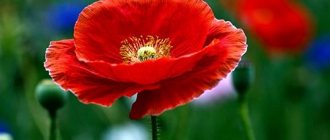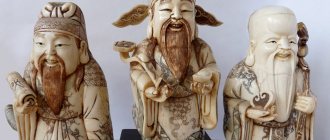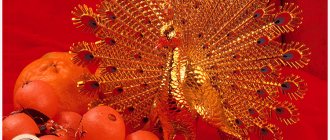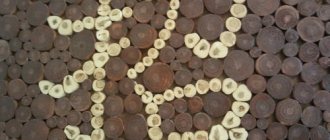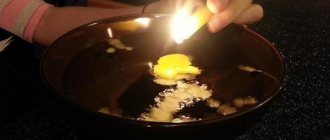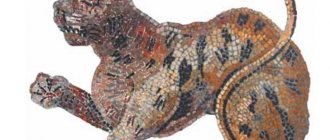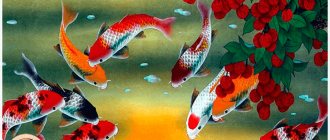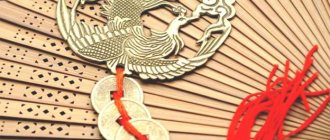Poppies are bright flowers that leave no one indifferent. Their beauty is eye-catching. Probably not everyone knows that this flower has a certain meaning for many peoples. Even in Ancient Greece they were considered the flowers of the gods. The Slavs treated them as flowers of angels. In ancient China, the poppy flower, like peonies, was revered for attracting love and improving relationships between relatives. The ancient Chinese teaching of Feng Shui also attaches great importance to these colors.
Feng Shui poppies, their meaning and properties
According to Feng Shui, poppies are considered magical plants. With their bright colors they attract positive energy and enhance it. According to teaching, flowers help a person achieve success in business, his business. If you contemplate them in solitude, it helps you make the right decision and brings a person into a calm, peaceful state.
But the main meaning of the flower is its beneficial effect on the sphere of love and relationships. They, like a magnet, attract true love to a person. They help you see and understand the real qualities of your chosen one.
Poppies are capable of influencing with their energy not only the creation and formation of love relationships. They help not to make mistakes in family life. Find the right way out of difficult situations. With their energy they increase the sense of responsibility and the sense of leadership. And this gives us the determination to take responsibility. Leads to improved relationships, mutual understanding, harmony.
According to Feng Shui, poppies harmonize not only love relationships, but also family relationships. In case of quarrels between children and parents, brothers and sisters, grandmothers and grandchildren, they promote reconciliation.
Another amazing property is that it attracts success in any business. He especially favors those who mind their own business and run their own business.
Symbolism is important in Feng Shui. Therefore, both living plants and images are used to make qualitative changes in one’s life.
If you use live plants, you need to know that they last no more than two days when cut. But during this time, with their strong energy they are able to influence the quality of a person’s life.
If possible, it is best to grow these flowers in a flower bed near the house. This will especially help businessmen and business people.
Flowering plants in a flowerbed provide us with a constant supply of beneficial, strong energy.
If living plants are placed near the bed, this will lead to the early birth of a child. It’s not for nothing that the goddess of fertility Demeter is depicted with a poppy in her hand.
Where to put flowers
It must be said that these flowers do not stay alive for long. Once picked, they wither within 1-2 days. But even in these few days they are able to have a beneficial effect on the interior space of the house. You can place the bouquet in the area whose energy needs to be strengthened. The bouquet looks beautiful in the kitchen, but if we consider it from the point of view of the teachings of Feng Shui, then the red poppy, as a symbol of fire, will best fit into the southern zone, which is responsible for fame and reputation. Such a symbol is also appropriate in the southeastern sector, which is responsible for the family.
Wherever the lady of the house places a bouquet of flowers, you can expect that it will lift the spirits and vitality of everyone who contemplates it.
What does a picture with poppy flowers mean according to Feng Shui?
If a painting depicting a lot of poppies, a lot of bright color, is placed in an apartment, then this will attract great passion into the life of the owners.
A painting painted in soothing colors brings calm and peace to the owners. It will also promote mutual understanding and harmony in the family.
If family relationships need to be intensified, add a little activity and fire, then feel free to place a picture with an abundance of red. This picture enhances the energy of Qi, which brings about dramatic changes in mutual understanding.
The energy of creativity and novelty will be attracted by a flower, which in the picture will flaunt alone among the dense green foliage. Such a picture can be placed in the creativity sector, located in the western direction.
Medicinal properties
The healing properties of poppy have been known since ancient times. The juice and grains of the flower were used to temporarily give a person the opportunity to get rid of pain.
Nowadays, this flower is used to create medicines. The plant contains healthy proteins, vitamins, fats and microelements.
The importance of poppy for medicine is enormous, since it is used to treat the following diseases:
- cough;
- insomnia;
- stomach;
- heart;
- kidneys
Medicines based on poppy have the following effects:
- relieve pain;
- eliminate cramps, spasms;
- treat some oncological diseases;
- reduce inflammatory processes;
- strengthen the body.
Unfortunately, the unique plant began to be used as a narcotic substance. In many countries, its cultivation has been banned.
Places in the house for poppies
Where is the best place to place it? To attract new love, you need to place poppies or images in the sector of love and relationships. For an apartment, this is the southwest sector or southwest of the room.
If you need to harmonize the relationship between spouses, then a painting or fresh flowers can be placed in the bedroom. With their energy they will help you calm down and make the right decision.
- If poppies are placed in the east, relations between households will improve. Also, a picture or bouquet can be placed in the living room, where the family most often gathers.
- For success in business, it is advisable to place poppies in the north or in the workplace.
- In the West, in the creative sector, flowers will attract success in all new endeavors.
Poppies can be placed in all areas of an apartment or house. Where they are placed, that area of life will receive an influx of additional energy. But wherever poppies stand, they are able to attract beneficial positive energy into family relationships.
Magic properties
In ancient times they believed that spirits lived in poppies. The flower was used for magical rituals, witchcraft, and fortune telling. Poppies were amulets against the evil eye and evil spirits. The grains of the flower were scattered during wedding ceremonies, in places where the woman in labor was with her child. Grains were scattered in the house so that the devilish forces would not get close to the owners.
A woman who could not get pregnant for several years put flower petals in the attic. They lay there for as many days as the couple had been unable to have children for years. Then the petals were burned.
With the help of flower seeds, spells were made for wealth and profit.
Poppies in the interior
What does football have to do with it?
Clubs and teams across Britain annually mark Remembrance Day at the matches closest to November 11: they hold a minute of silence, invite veterans to the stadium, place red poppies on their T-shirts - and also donate money. The Premier League has supported the Royal British Legion since 2012 and has since donated £1.3 million .
Sometimes, however, the Premier League is accused of untimely ceremonies: some clubs hold them in the last days of October, since Remembrance Day itself falls during the national team break.
Mystical poppy
By the way, about the supernatural. Rare love divination is complete without self-seeding poppy . The easiest way is to collect the seeds of such a poppy in your right palm on the waxing moon at night and carry them in your pocket, thinking about your chosen one. You can not carry the grain, but scatter it across the field against the wind with the sentence:
This harmless homemade way to bewitch the groom only lasts for six months, and then the spell wears off! Therefore, girls, hurry up to tie your betrothed to you tightly during this time! Otherwise, you will be left with your nose. However, if you suddenly don’t like the candidate for your hand, then you won’t need to make a lapel.
Why is the red poppy not our symbol?
While the impressions of the May holidays have not yet cooled down, we should dwell on one ambiguous fact. It is no secret that in many countries this year such a movement intensified - against the St. George Ribbon, as a symbol of the Victory of the Soviet people. And, accordingly, the propaganda of a new sign of sadness and memory for some countries of the post-Soviet space – the red poppy – has also intensified. Nobody did any special explanatory work, which ended in another stage of media confrontations.
With Ukraine, one can understand - for more than one year now, the need has periodically surfaced for at least something to replace the classic symbol of Soviet Victory. There was nothing to replace it with. This is understandable - Victory was directly associated with Saint George the Victorious himself. Can you replace a saint? And also the Victorious?
This year, on May 9, the Ukrainian authorities very expressively hinted that no one should use this symbol on Victory Day. But neither a law prohibiting wearing a ribbon nor legally officially approving any new symbol in Ukraine has been adopted.
Having just come to our senses, after May 9 itself, a bill is being prepared from deputy Anton Gerashchenko to ban the wearing of St. George’s ribbons.
It is clear that as a result of the military conflict in Ukraine, the warring parties use their own specific symbols. And everyone knows how painfully some Ukrainian radicals react to many symbols of Novorossiya. St. George's Ribbon is no exception.
Suicide sign
This hole of hatred, at least by Victory Day, simply had to be replaced with something. So they replaced it with red poppies. They were motivated by the fact that throughout civilized Europe this is a symbol of memory for the victims of the Second World War.
But this is an outright lie. The red poppy, as a symbol of remembrance of the victims of the war, has nothing to do with either May 8 or May 9. But the rabid hatred that the promotion of the red poppy symbol caused in networks and some media is also not entirely correct. Even though it is interpreted in terms of design, this symbol in the Ukrainian version is unsuccessful and even disgusting. As many have noticed, there is literally a bullet hole covered in blood. The so-called designers from Kharkov themselves do not reject this. You should know the names of these "heroes". This is Sergey Mishakin and Tatyana Borzunova.
“This is not a symbol of Victory at all, but a sign of memory of those who died during the Great Patriotic War,” Sergei Mishakin explains the essence of his creation. “And since in Europe the poppy flower has long been a symbol of memory for the dead, my co-author Tanya Borzunova and I decided to take it as a basis and create our own sign - red circles superimposed on each other and a black dot in the middle.”
Just think about it - they write that they created their own sign, ignoring the symbol that already exists in Europe, and they themselves admitted that the poppy is a sign of memory of those who died “during the Great Patriotic War.” Sergei Mishakin, claiming to be the designer, did not even bother to find out the history of the symbol. The story of the “creation” of this new Ukrainian symbol is even more interesting. This happened at the suggestion of a person who had no relation to the leadership of the country. The director of the National Television and Radio Company of Ukraine - of course, a Georgian - Zurab Alasania. A close friend of Arsen Avakov. Alasania turned to his Kharkov friend “designer” Mishakin and suggested doing something as quickly as possible by May 8-9. That is, all three of us are from Kharkov - Avakov, Alasania (lived in Kharkov) and Mishakin and his colleague.
Here’s what Alasania himself said about this: “The St. George ribbon has irrevocably compromised itself in recent months; we needed something significant that would symbolize not a holiday , which war cannot be by definition, but memory and grief,” said Alasania. – Sergey found this symbol quickly, without even stuttering about payment. He gave it to me and the National Channel. The Institute of National Remembrance also received it. If he finds it necessary, he will use it.”
Listen, Zurab - war is really not a reason for joy. But Victory is a reason for joy and celebration. But, let's leave Alasania's conclusion about the sign of Victory, let's better concentrate on it itself. There is such an episode in his life - an unsuccessful attempt to enroll in the French Legion. This legion is famous for the fact that people of dubious past and present can find refuge in it. This legion even has a tradition of not asking the names of recruits who want to enlist. Now, however, a person is “examined” for several days, isolating him from the outside world. Nothing is taken into account (even possible crimes), except when wanted by Interpol. If the check goes well and the physical data meets the requirements, the person is accepted into the legion - they are given new personal data, a name and even new names of relatives. In essence, this is a legalized gathering of refugees from the law. Read the terms of service in the legion - and everything will become clear to you. So Alasania spent time at the inspection for nothing - he came in 1996, and left the same year. Why - history is silent. There is only one controversial phrase on Wikipedia. “In 1996 he went abroad again - under a contract with the French Foreign Legion, but did not sign a contract.” Did you understand something? What is it like to leave under a contract, but not sign a contract? But we should dig up - who is running the First Broadcasting Channel in Ukraine today? What Zurab himself says about the legion: “I saw the guys who have been serving there for a long time. A mountain of muscles, a whole body covered in tattoos and zero in the head. I saw what awaited me, and I had to decide whether I agreed to become like that. I realized that it’s not.” Then why does he say the following: “After the Soviet army, I first came to their dining room, saw fried asparagus wrapped in ham, a bottle of wine for six and went crazy. But these are minor things. The main difference is that you don’t have to think about anything there. They think for you. I needed it then .” What did Georgian Alasania need with 150 dollars in his pocket in the French Legion - to hide, change his first and last name or something else - let the relevant authorities investigate, because... he himself wrote nothing concrete in his sparse essays about that period.
This is Alasania, with an incomprehensible past, who stimulated his friend to create this bloody symbol with a bullet hole, instead of the St. George Ribbon.
There is another cynical fact in this story that is striking. Alasania, Mishakin and Borzunova believe that they have found just such an image. What, tell me, did they need to look for? The poppy flower has existed in the associative series of symbols for a hundred years. So it was necessary to deface the flower at the level of plagiarism, transforming it into some kind of ritual sign of murder, which people should also put on themselves? To the area of the heart? No one gave the right to just such a creepy interpretation, when for 100 years it is the flower that has been used, and not a bullet hole?
Real story
Officially, throughout the world and in civilized Europe, the red poppy is a symbol of Armistice Day, which is celebrated not on May 8, but on November 11, and most famously in London. Because it is in London that there is the oldest factory or even a plant for the production of paraphernalia - artificial red poppies, wreaths and crosses. It is with grave crosses, and not with the Victory over fascism, that the symbolism of the red flower is associated. And among those who produce and buy it, it is called not red poppy - but bloody poppy or flower of memory.
Why exactly November 11 - because it was on this day that an agreement to end hostilities between the Entente and Germany was signed in the French region of Picardy. Hence the name - it is Armistice Day, and not the day of reconciliation. Truce as one of the actual results of any military conflict. Another result of the end of a war, as you know, is the victory of one of the sides. By the way, the poppy, the truce of a hundred years ago, and the autumn date itself have nothing to do with the great Victory over fascism.
That’s why for all these 100 years “Armistice Day” has been celebrated in Western countries - France, Belgium, Canada, Great Britain, then in the USA and Australia. And it was established as official by the British King George V back in 1919.
However, such popularity of the day of red poppies in England is understandable. During the First World War, British losses amounted to less than a million people - 888,246.
This story developed during the First World War. According to the observation of a military doctor from Canada, John McCarey, who witnessed the bloodiest battles in Flanders, not far from the city of Ypres (Belgium) in 1915 (during one of which the Germans used the first chemical attack) in the spring at the battle sites and at some burial sites wild self-seeded poppies bloomed very profusely. It is not surprising that their appearance, swaying in the wind, among the grave crosses, evoked comparison with sprouted drops of the blood of the dead, as if in memory of them. Let us remember that at that time it was in these battles that Germany took part on one side. On the other - England, France, Belgium. The countries of Eastern Europe and, especially, the troops of the Russian Empire (including the Ukrainian ethnic group) did not participate in them. According to rough estimates from the Entente (mainly the French and British), about 250,000 soldiers were killed in these Flanders fields near Ypres. It is not surprising that in wartime conditions many remained unburied. Subsequently, some were buried, others were not. In total, there are at least one hundred and forty military cemeteries and memorials around the city of Ypres!!!!
Hence this touching poem by a Canadian military doctor:
Everywhere poppies are burning with candles of sadness On the war-scorched Flanders fields, Between the gloomy crosses that stand in rows, In those places where our ashes were recently buried...
This poetic ballad was translated into many languages and resonated with all those who lost loved ones in those battles. With enthusiasm they accepted the new symbol of memory proposed by the American Mona Michel. Sometimes, in the American style, they call her Mona Michael. But it wasn't so much the symbol of the poppy that she suggested. She was looking for an opportunity to support disabled veterans of that war. Therefore, she invited like-minded people to make artificial poppies from fabric, sell them, and use the proceeds to support veterans. Of course, poppies had to be popularized. Therefore, Mona vowed to always wear an artificial red poppy on her clothes. She made the poppy a fashionable charity trend. This is where the tradition of celebrating November 11 comes from, not only as a day of remembrance and truce, but also as a day of charity for war veterans, collecting donations, helping lonely veterans, providing medicines and other necessities.
And what about Ukraine? Having untied the red poppy from the legal date of November 11 and tied it to May 8-9, advising to forget about the St. George ribbons, what kind of charity are the authorities doing for retired veterans? They impose an additional tax on their pensions and, most strikingly, a military tax. In a pre-default state, prices for medicines in the country increased - some by 8 times. Pensioners cannot buy them. The red poppy is a symbol against war with the motto “Never again” - specifically about the non-repetition of war. And in Ukraine, they fleece veterans with exorbitant tariffs for housing and communal services and redirect all these levies to the military conflict... Yes, not only veterans were levied with levies, but also their descendants of the winners.
Well, that's by the way.
Mona Michel's initiative found support. Already in 1918, French widows of the dead began making poppies for the sake of the living. But since this action did not yet find support in France, these women had to arrive by ship to Great Britain, where poppies made by the widows' hands were bought with better understanding and in large quantities. Then the active Frenchwoman Madame Guerin joined the event. She made artificial poppies, the proceeds from the sale of which she sent to widows and orphans whose fathers died on the fields of that war. In any case, it was charity that became the core - or better said - the stem on which the tradition of red poppies blossomed in European countries and further in America.
And in England already in 1921 - on November 11, the very day the First World War ended, the first official Red Poppy Day took place. The scale of the event and the support of the people inspired the capitalist world. The very next year, Major John Howson founded the first society for disabled people, where they could support each other. This is precisely why Major Howson opened a factory in Kent to produce poppy paraphernalia. The major employed veterans like himself, many of whom were disabled. The year 1923 was already marked by a million artificial flowers of memory. John Howson did not stop and registered a charitable society to provide work for those who returned from the war and found themselves in difficult situations. His Poppy Factory Foundation in Richmond continues to operate and provides programs that return veterans to normal life and civilian employment throughout the country.
You may ask, did Russia also take part in the First World War? Yes, and it’s quite possible that I would join the poppy campaign on November 11th. But by the end of that war, that Russia no longer existed. Civil war and party political confrontations raged in its vastness.
Interpretation.
In England, the permanent location for installations of poppies is the area near Westminster Abbey and the Tower. Queen Elizabeth, November 11th officially patronizes this day. They make artificial fields from artificial poppies, and also specially plant live poppies. Auctions are held. Veterans assistance funds still exist today. Many of the former military men, who received not only physical but also mental injuries while working in the production of symbols for Armistice Day, are literally cured of mental disorders and alcoholism. At the Tower of London, a crimson sea of ceramic poppies covers an ancient moat in a stunning exhibition called Bloodstained Lands. In total, the number of these poppies is 888,426 - each representing a British soldier who died during the First World War.
But this is Britain. But what about other countries and the poppy symbolism in general?
Since ancient times, it symbolizes two opposing views of the universe. On the one hand, it is a symbol of youth, the beauty of fertility, and even sometimes permissiveness. In Ukrainian villages, there has long been a tradition of sprinkling wedding ceremonies with poppy seeds, and strewing the bed and wedding loaves with poppy petals - for the wish of having as many children as possible. This flower is associated with fertility and endless spaces. And today poppy flowers are often found on women’s Ukrainian embroidered shirts – as a symbol of joy and feminine beauty. But in no way a symbol of sadness, death, memory and contrition...
But in China it is a symbol of the accessibility of some women. In Persian culture, the poppy is a symbol of happiness, eternal love, and joy. Buddhists are convinced that the poppy appeared after the falling asleep Buddha touched the ground with his eyelashes. In most cases in the East, the poppy flower was associated with success, beauty, relaxation and distance from the hustle and bustle.
And more ancient myths interpret poppy as a means of hypnosis and mental pain relief. But precisely as a symbol of burials, the poppy has been known since the times of Egyptian civilization. Among traditional medicine and doctors, there is an established opinion about the danger of poppy decoction - which can put a person into a lethargic sleep or even kill. Indeed, maybe the lines of that Canadian military doctor of the First World War arose from genetic memory?
Fields in Flanders, the poppies rustle Between the crosses, where in a row there is a row….
Therefore, death, sleep and poppy have often proven their relationship in practice. Suffice it to recall the legends about how they were specially doused with poppy seeds. Or how they calmed children with milk of the poppy in large quantities, unintentionally killing them. Therefore, it is quite difficult to unambiguously interpret the symbol of the poppy flower.
Now in some countries on Armistice Day there is a tradition of wearing boutonnieres in the form of red poppies on the lapel of a jacket, in a buttonhole or on other outerwear, not only in memory of those who fell in the First World War, but also in the Second World War. The West loves globalization. Absolutely not remembering the wars in Serbia, Iraq, Donbass... he limits himself only to wars on a global scale. The only good thing is that the proceeds from the sale of these boutonnieres go to help veterans and their families. In Ukraine, they somehow didn’t think of using the red poppy event as a charity event. Now I wonder - will Ukraine take part in the real Day of Armistice and Remembrance on November 11? If we really strive so zealously to join European values? And specifically to the Anglo-Saxons?
But Russia, I think, despite the constant accusations of aggression, it is quite possible to join in on Memorial Day on November 11 with wonderful and beautiful flowers. We even have a song by Yuri Antonov about red poppies:
Poppies, poppies, scarlet poppies Eternal memory of the earth Can you really stop the attacks of those who did not come from these fields.
And, at the same time, Russia can hold a large-scale charity event in support of veterans, showing the whole world the level of culture and respect for those who died on the battlefields of both the First World War, the Civil War, and all wars in general.
And I’ll preempt the question - why, for example, in Russia don’t they make a charity event out of all this - I mean - the St. George’s Ribbon? More precisely, why is it not sold for charity, but given away for free?
I answer - this tape is not for sale. It is passed down from generation to generation as a reward. Moreover, this sign of the second option for ending the war is not a truce (which is what the red poppy became in the symbolic format), but a complete and final Victory. And the St. George ribbon remains the only symbol of the Victory of all peoples who defeated fascism. Whichever country recognizes this symbol is an accomplice in the Great Victory of St. George over the serpent of world evil.
Andrey Yanitsky
Where is the best place to hang a picture?
Growing poppies at home is not an easy task. The optimal solution would be to purchase a painting depicting bright flowers. The strength of the herbaceous plant’s influence on a person depends on the place where it hangs.
To improve the relationship between spouses and to conceive a child as soon as possible, you should place the panel in the bedroom.
The wall of the living room or hallway would also be a suitable place for the painting. This location promotes ease of communication and creates a friendly and comfortable atmosphere.
To improve the relationship between parents and children, it is recommended to hang a picture with poppies in the children's room. Such an arrangement of the image of flowers can correct the relationship between different generations and show them the path to compromise.
A painting with poppies will be a beautiful decoration for your home and a symbol that works for successful family relationships.
Poppy flower: meaning, description
Many gardeners and summer residents associate these flowers with drugs. In reality, everything is not quite like that.
It is forbidden to grow the poppy flower, or opium poppy. Its height is about a meter, the flowers are large (10-12 cm in diameter), white, pink, orange, red, purple, with a black-bluish spot at the base.
The seeds of this poppy are edible. Morphine and opium are obtained from the seed pods. In addition, there are many different types of ornamental poppies that do not have narcotic properties. All of them are divided into three groups: perennial, annual and biennial.
Poppy (flower): description
This plant is from the Poppy family. The entire genus has more than 100 species. From Latin the name is translated into Russian as “milk”. Why? The fact is that when the flower stem is cut, a white juice similar to milk is released.
The bush of the plant usually has a height of almost 90 cm, sometimes small, dwarf forms are also found. It has a hard, hairy stem. The leaves are pinnate, dissected.
Large flowers are single, among which there are both simple and double species. June is the month of poppy flowering, after which the flower stalks and then the leaves and stems die off.
In nature, perennial poppies are common in Asia, Europe and Australia.
Choosing a site for planting and care
The poppy flower loves a well-lit place, but slightly shaded areas are also not contraindicated for it. The soil is suitable: ordinary garden soil, but well drained. Rich in minerals and nutritious, flowers will like it even more. Poppies are unpretentious, frost-resistant, and can easily withstand periods of drought.
After the end of flowering time, when the leaves are already beginning to turn yellow, the above-ground part must be cut off. In this case, around mid-August, the leaves begin to re-grow. In a warm autumn, the plant may bloom again. And the leaves may turn green under the snow. In April they begin to bloom again.
Perennial poppies can be planted either individually or in mixed groups (in rockeries). Both flowers and capsules are widely used as cut flowers. For example, boxes are a good material for original dry winter bouquets.
Reproduction
The poppy flower is usually propagated by seeds. Sowing can be done both in spring and before winter, and in open ground. It is advisable to plant immediately in a permanent place of growth. If necessary, seedlings can be thinned out.
The roots of adult plants are quite long, so it is difficult to replant them, as damage to the root system is possible.
Oriental poppy can also be propagated by division, as it has root shoots. However, this procedure must be carried out in the summer immediately after flowering, during dormancy.
The most common garden flowers are poppies. Kinds
In floriculture, the most widely used and widespread are oriental poppy and bract. They are the brightest and most beautiful.
The homeland of the oriental poppy (P. orientale) is the Caucasus. This perennial has thick, erect stems. Their height is up to 100 cm.
The pinnately dissected basal leaves, collected in a rosette, are dark green (length - up to 30 cm). Its stems, leaves, and buds are pubescent and shaggy.
Large bright red flowers are up to 14 cm in diameter. At the very base of the petals there is a black square spot.
The type of bract poppy (P. bracteatum) is also native to the Caucasus. Its height reaches 140 cm. The stem is erect, the flowers are bright, crimson-red (diameter 16 cm).
And at the very base of the petals there is an elongated black spot. It blooms quite profusely, starting in late May and ending in early June.
Different varieties of this species differ in bush height, color and size of flowers. Both species are perennial flowers (poppies).
Perennial flowers: care
Perennials are of three types: alpine, oriental and holostem. The most widespread among gardeners, as noted above, are varieties of oriental species.
Perennial poppies do not require shelter for the winter; they are light-loving, winter-hardy, and tolerate drought well. There is a minor whim - stagnation of water is undesirable.
The poppy flower is very responsive to organic and mineral fertilizers.
This species can be propagated vegetatively by carefully separating the side rosettes in spring or autumn. Without transplantation, poppies grow for about 7 years.
Flowers look great in a group with other plants (among daisies, bells, etc.). Dwarf varieties are great for today's fashionable alpine slides.
Annuals
If there are annual poppies on the site, how is care done? These include the self-sowing plant. These poppies come in simple and double varieties. Their colors vary from white to red, and there are also white ones with a border around the edges of the petals. Garden poppy is also good and interesting. Its flowers (double varieties) resemble peonies.
Annual poppies can be sown in early spring, after the snow has melted. They produce abundant self-seeding, so it is enough to sow them just once.
Bouquets with poppies are a wonderful decoration for any room, but there is one drawback - they don’t last long after being cut.
There is a little secret that prolongs the life of flowers. They need to be cut off in the morning, and only the burst buds. Then the cut site must be held over the fire for several seconds, and then immediately placed in water. You need to add a few crystals of potassium permanganate to it. The bouquet will last longer.
Source: pr-perevod.ru
Choosing a site for planting and care
Poppies love sun, so plant them in an open, sunny area. Sow the seeds in loose, sandy soil. After five years, it is recommended to transplant the flowers to another place. Since the roots grow greatly, they are divided for replanting.
The plant does not require special care. Water it so that the moisture does not stagnate. Overwatering causes the roots to rot. Diseases and harmful insects rarely damage the plant. If the flower has grown tall, secure it near a support so that it does not break.
Poppies fade very quickly, after which cut off the dried above-ground part of the flower.
Case of James McClain
It wasn't just FIFA that didn't like the tradition of wearing poppies on T-shirts every year. Irish midfielder James McClain has ideological rather than bureaucratic reasons for this. Since 2011, the winger, who then played for Sunderland (now at West Brom), has refused to wear the red flower and these days receives streams of whistles and hatred even from his club's fans.
McClain is from Derry, Northern Ireland, where Bloody Sunday happened in 1972: British troops shot at a demonstration of local residents who had come to march in defense of civil rights in Northern Ireland. 13 protesters were killed, and the conflict between the Irish Republican Army and the British armed forces flared up with renewed vigor.
In 2010, David Cameron apologized to the victims and their families on behalf of the state, but McClain did not accept the apology.
“I am full of respect for those who fought and died in both world wars,” the footballer explained his position. “I mourn their death and, like any other decent person, if the poppy were a symbol of only this, I would wear it every day.” However, the poppy also symbolizes the memory of British soldiers who served in conflicts after 1945 . And this is where the problem begins for me. To people in the north of Ireland who understand what happened on Bloody Sunday 1972, the poppy means something very different . For me, wearing a poppy would be a gesture of disrespect for the innocent people who lost their lives during those troubled times. I want everyone to understand this 100%. I am a man, and my upbringing does not allow me to deviate from my convictions.”
McClain has repeatedly demonstrated his political leanings: in 2015, the Irishman turned his back to the English flag and lowered his head during the British anthem, and after the referendum on Britain’s exit from the European Union, he called on Ireland and Northern Ireland to unite with a tweet “Let’s light the fires of reunion.”
Photo: Gettyimages.ru/Clive Rose, Laurence Griffiths, Mike Hewitt, Richard Heathcote, Steve Bardens, Dan Mullan, Richard Heathcote, Shaun Botterill, Michael Regan, Jordan Mansfield, Matthew Lewis, Clive Brunskill, Charles McQuillan
